Guide to Railway Stations in Tibet
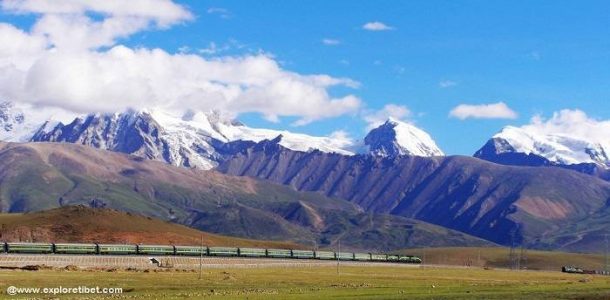
Qinghai Tibet Railway in Tibet Autonomous Region
Lhasa Railway Station
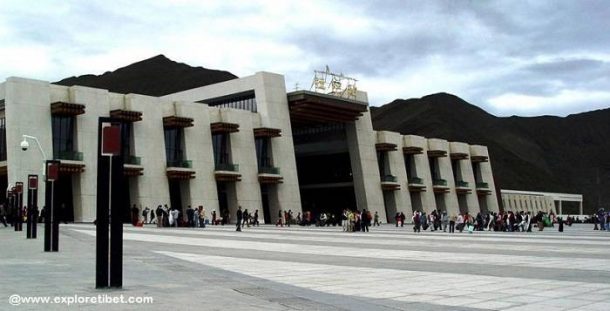
Lhasa Railway Station, to the south of the Lhasa River
The main railway station in Tibet, Lhasa Station lies to the south of the Lhasa River, at an altitude of 3,641 meters. The station was completed in 2006, and was officially opened on July 1, 2006. The final destination of trains on the Qinghai-Tibet Railway, Lhasa station sees 2,700 visitors a day pass through its temple-like entrance. The station is host to over 15 trains per day, and is the main hub of rail travel in Tibet AR.
Inside the station is a three-floor structure, with the lower floor below ground. The interior includes ordinary waiting rooms, as well as soft seat waiting rooms and a VIP lounge, with tapestry-decorated walls and lush carpets. The station also includes a large market for shopping, and has a very modern interior design, with a completely column-free concourse.
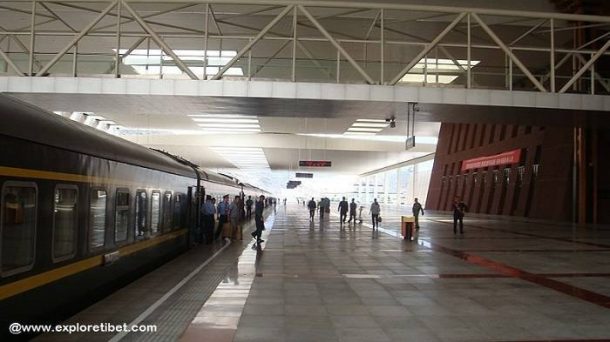
Lhasa Station Platform
The station has 10 tracks, two of which are for freight trains, and seven platforms, and arrivals are located at the underground floor. For those arriving, there are bus terminals at both sides of the buildings, providing both local and regional transportation. Taxis can be found on the main road in front of the station for those wishing to travel to Lhasa by cab. Travel into Lhasa, and to places like Potala Palace and Barkhor Street, takes around 20 minutes, and the road crosses the river to get into the city.
Shigatse Railway Station
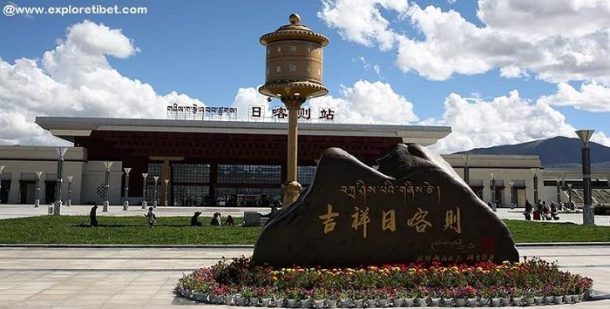
Shigatse Railway Station, the terminus for the Lhasa-Shigatse Railway
Shigatse Railway Station is the hub that connects western Tibet with Lhasa and the rest of the world. Situated in Zhandui village of Jiacuoxiong town, the station is almost 10km south of Shigatse downtown. The station is decorated in the traditional red and white, and looks like a smaller version of Lhasa station, with its large front windows and covered, temple-like entrance.
The station went in operation on August 15, 20014, after the completion of the 253km-long railway line that starts in Lhasa. This extension of the original Qinghai-Tibet Railway is known as the Lhasa-Shigatse Railway, and is the staging point for the next, planned leg of the line – the extension into Nepal. Once that is completed, Shigatse will become a major hub for Tibetan tourism in the area.
Shigatse is a major city in the area, and the second largest city in Tibet, with an average population in excess of 720,000, and governs the city district as well as 17 counties. It has had a long history of over 600 years, and houses one of the residential palaces of the Panchen Lama – Tibet’s second highest religious figure. Shigatse also plays a major part in tourism for Mt. Everest, as the world’s highest mountain is in Shigatse Prefecture. Many tourists come to the city on the way to the mountain’s Base Camp, and to visit the famous Tashilhunpo Monastery, which is only 20 minutes away from downtown on foot.
Nagqu Railway Station
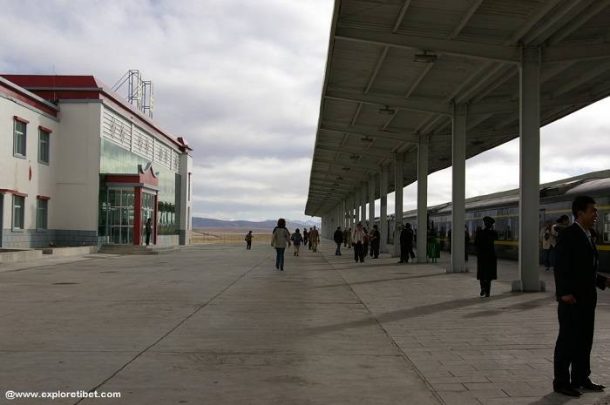
Nagqu Railway Station, located in Mendi Town of Nagqu County
Nagqu Railway Station was first built in 2006, and is located in Mendi Town of Nagqu County. The station is close to the Qinghai-Tibet Highway, and it is mainly a transfer and supply station of the Qinghai-Tibet Railway.
Nagqu is also the highest station in Tibet AR, at an altitude of 4,547 meters above sea level, although it is not the highest station on the Qinghai-Tibet Railway. The station covers a total area of 7,412 square meters, and its building houses both ordinary and soft-sleeper waiting rooms, where passengers can enjoy the beautiful scenery of the Changtang Prairie through the large windows. This vast highland prairie is full of crystal-clear lakes, sheep, yak, and a vast, expanse of grassland bordered with snow-capped mountains.
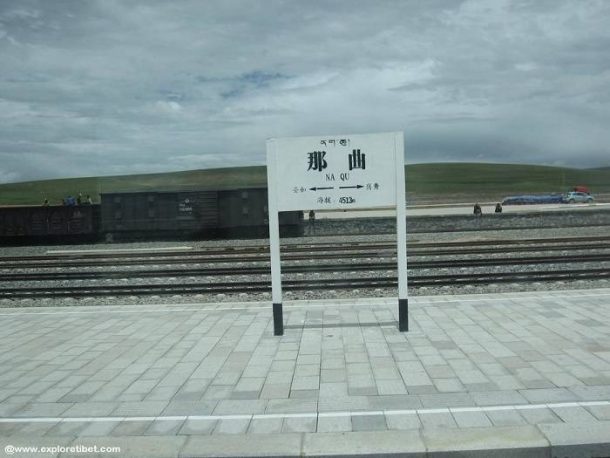
Nagqu Station Sign as viewed from the Tibet train
Nagqu District of Tibet governs Nagqu County as the major cultural, political, and information and communication hub of North Tibet. Situated between the lofty Tanggula Mountains and the Nyainqentanglha mountains, Nagqu covers an area of almost 16,200 square kilometers.
The area is also host to one of the most famous events in Tibet, the Nagqu Horse Racing Festival. Held on August 1 every year, it is an important festival in the Tibetan calendar of events, and visitors often travel on the train from Lhasa to attend. In addition, nearby is the famed “heavenly lake”, Namtso, a major tourist destination, and the second largest saltwater lake in China. Namtso is also the world’s highest lake, and is over 70km long.
Tanggula Railway Station
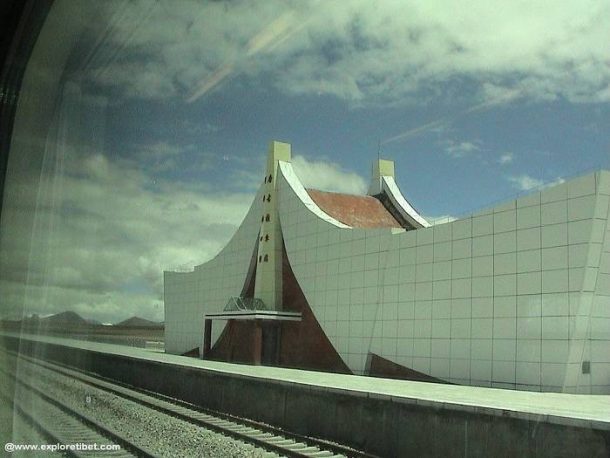
Tanggula Railway Station, the world’s highest at 5,068 meters above sea level
At the very roof of the world lies Tanggula Railway Station. The highest railway station in the world, Tanggula sits 5,068 meters above sea level, and is the highest station of the famous Qinghai-Tibet Railway. The station boasts three station tracks and two platforms, and is a comprehensive station for both passenger and freight transport. Although it only has one waiting room, it is fully equipped with large oxygen generating equipment.
However, since the region is completely uninhabited, there is no passenger transport service from the station. Passengers traveling to and from Tibet are not permitted to get down from the train, even though it often stops there to let an oncoming train pass.
The views here are spectacular, and the grand Tanggula mountain range can be clearly seen through the windows of the trains. The trains along this track pass through the Tanggula Mountain Pass, the highest railway pass in the world, at 5,231 meters. Tanggula means “mountain on plateau” in Tibetan, and Tanggula Mountain is the source of the Nujiang River, the Lancang River, and the Yangtze River.
Damxung Railway Station
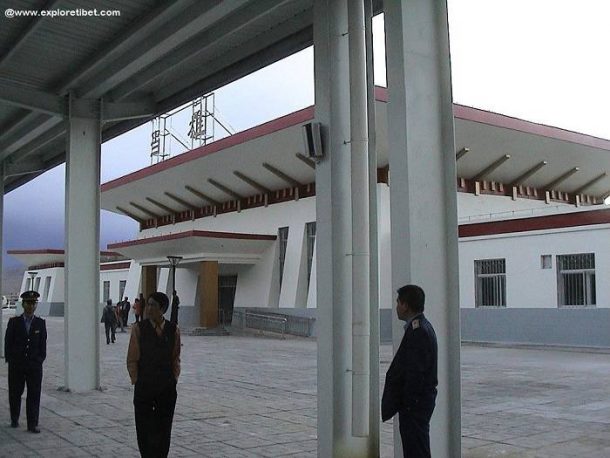
Damxung Railway Station, at 4,293 meters, lies between Nagqu and Lhasa
At an elevation of 4,293 meters, Damxung Railway Station is on the Qinghai-Tibet Railway, between Nagqu and Lhasa. Although small, the station is one of the stops of the Tibet Trains from both Xining and Lanzhou. The station consists of the normal waiting rooms, and benefits from two small restaurants, Shenghu and Linxia, and a supermarket, as well as two traditional tearooms. Two trains from either direction stop there for a few minutes each day, and passengers can get a great view of the mountains either side of the valley. Just beyond the mountains to the northwest lies Namtso Lake, with its crystal waters.
Damxung means “the selected pasture”, and the area of the valley in which it lies is grassy and wide. It is another 160km to get to Lhasa, which is around 3.5 hours driving time. The town is an important supply area for the region, and Damxung has large warehouses off the main street, which supply clothing and equipment for trekking and mountaineering. The town is modern and the County was one of the first in Tibet to outlaw the production and use of non-biodegradable plastic food containers and bags in 2005.
Recent Posts
The 7 Best Ways to Enjoy Tibet Tours in Winter
Winter Special in Tibet
Why Visit Tibet in Winter
All Categories
- About Tibet
- book a Tibet tour
- Buddhism Practice
- Budget Tour
- China-Tibet Train
- Customized Tibet tour
- Historical Sites
- Hot Springs in Tibet
- News
- Photography in Tibet
- Tibet attraction
- Tibet Group Visa
- Tibet Motorcycle Tour
- Tibet Small Group Tours
- Tibet Tours and Tibetan Tour Guide
- Tibet Train
- Tibet Travel FAQs
- Tibet Travel Information
- Tibet Travel News
- Tibet Travel Permit Update
- Tibet Travel Prices Rises
- Tibet Trek
- Tibet Trekking Tour
- Tibet weather and climate
- Tibet Wildlife animals
- Tibet Winter Tour
- Tibetan Buddhism
- Tibetan Cultural Features
- Tibetan Culture and Poeple
- Tibetan Festivals
- What to see in Tibet



